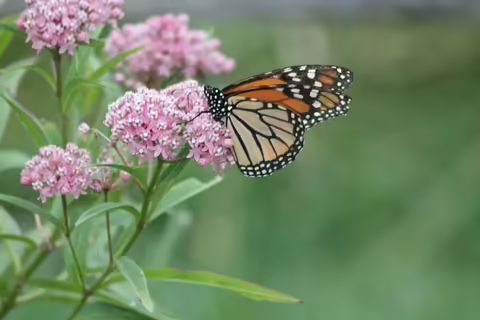URBANA, Ill. – Pollinators are responsible for an estimated one in every three bites of food that humans eat, so it’s no wonder they’re getting a lot of buzz these days. For those who want to support these hard-working environmental contributors, but don’t have a large yard or outdoor space, container gardens are the answer.
There are a few things to consider when creating a container garden that will attract and support pollinators throughout the growing season, says Nancy Kreith, University of Illinois Extension. horticulture educator.
Pick a location that has full sun, at least six hours of daylight, and fill it with plants that will thrive in that condition.
“You will have the most success with plants that are drought-tolerant,” says Kreith. “That way, you will not have to water as much. Annuals are a good choice, but you can also select Illinois native perennial plants.”
One combination may be a short variety of zinnia as a border and cosmos as a centerpiece. Another option is lantana as a border and a shorter variety of sunflower, 3- to 4-feet tall, as a centerpiece. Marigolds can work as a border plant for annual blue salvia.
“I’ve had great success in attracting hummingbirds with ‘Black & Blue’ salvia,” says Kreith.
Native perennials that perform well in containers include purple coneflower, prairie blazing star, bottle gentian, lanceleaf coreopsis, prairie smoke, and field pussytoes.
Herbs grow well in containers. Dill, fennel, and parsley are host plants for the black swallowtail butterfly. Other herbs with significant blooms include lavender, chive, nasturtium, thyme, basil, borage, and hyssop. Group herbs based on their size when fully grown and watering needs.
“Lavender and thyme are both fairly drought tolerant, so that would be a good combination,” says Kreith.
Borage and nasturtium also work well together with borage filling the bulk of the pot while a trailing variety of nasturtium will spill over the side of the container.
Choosing the appropriate container is important. It should be large enough to support plenty of plants and have drainage holes at the bottom.
Kreith recommends using a soilless potting mix that is peat or coir based and includes a mineral, such as perlite to allow for better drainage. Add fertilizer or use a potting mix that already contains it.
Water plants until it drips out of the bottom of the container. Smaller containers will need to be watered more often.
“During hot months, daily watering is typical,” says Kreith. “Larger containers will not dry out as fast, so every other day watering may be enough.”
Deadhead spent flowers to encourage reblooming and avoid unwanted reseeding. Monitor your perennials for stress levels and replace if they become unsightly or die.
Once the growing season is over, Kreith says containers can be brought indoors and overwintered in a garage, shed, or basement. If you’re going to leave them outside, group containers together in an area protected from wind, then water them and cover with a thermal blanket, straw, shredded leaves, or other mulch.
SOURCE: Nancy Kreith, Horticulture Educator, University of Illinois Extension
ABOUT EXTENSION: Illinois Extension leads public outreach for University of Illinois by translating research into action plans that allow Illinois families, businesses, and community leaders to solve problems, make informed decisions, and adapt to changes and opportunities.
PHOTO ACCESS: The photo in this article is available to download for media use.
